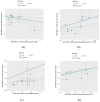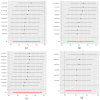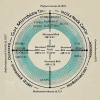Gut microbiome's causal role in head and neck cancer: findings from mendelian randomization
- PMID: 39628997
- PMCID: PMC11611831
- DOI: 10.3389/fonc.2024.1453202
Gut microbiome's causal role in head and neck cancer: findings from mendelian randomization
Abstract
Introduction: The gut microbiome (GM) has been implicated in cancer pathogenesis and treatment, including head and neck cancers (HNC). However, the specific microbial compositions influencing HNC and the underlying mechanisms remain largely unknown.
Methods: This study utilized published genome-wide association studies (GWAS) summary data-based two-sample Mendelian randomization (MR) to uncover the GM compositions that exert significant causal effects on HNC. Functional annotation and enrichment analysis were conducted to better understand the significant genetic variables and their connection with HNC. The HNC dataset included 2,281 cases and 314,193 controls. The GM GWAS data of 211 gut taxa (35 families, 20 orders, 16 classes, 9 phyla, and 131 genera) were obtained from the MibioGen consortium, involving 18,340 participants.
Results: MR analysis revealed four GM compositions exerting causal effects on HNC. Specifically, family Peptococcaceae.id.2024 was significantly associated with a 35% reduced risk of HNC (OR=0.65; 95%CI=0.48-0.90; P=0.0080). In contrast, genus DefluviitaleaceaeUCG-011.id.11287 (OR=1.54; 95%CI=1.13-2.09; P=0.0060), genus Gordonibacter.id.821 (OR=1.23; 95%CI=1.05-1.45; P=0.012), and genus Methanobrevibacter.id.123 (OR=1.28; 95%CI=1.01-1.62; P=0.040) showed a significant association with an increased risk of HNC. These GMs interact with genes and genetic variants involved in signaling pathways, such as GTPase regulation, influencing tumor progression and disease prognosis.
Conclusions: Our study demonstrates, for the first time, the causal influence of specific gut microbiome compositions on HNC, offering significant insights for advancing clinical research and personalized treatments. The identified GMs may serve as potential biomarkers or therapeutic targets, paving the way for innovative approaches in HNC diagnosis, prevention, and therapy.
Keywords: Mendelian randomization; enrichment analysis; functional annotation; gut microbiome; head and neck cancer.
Copyright © 2024 Lian, Sun, Han, Baranova, Cao and Zhang.
Conflict of interest statement
The authors declare that the research was conducted in the absence of any commercial or financial relationships that could be construed as a potential conflict of interest.
Figures






Similar articles
-
Plasma proteins mediate the effects of the gut microbiota on the development of head and neck cancer: a two-sample and mediated Mendelian randomized study.Discov Oncol. 2025 Feb 19;16(1):202. doi: 10.1007/s12672-025-01983-9. Discov Oncol. 2025. PMID: 39969766 Free PMC article.
-
Roles of gut microbiome in epilepsy risk: A Mendelian randomization study.Front Microbiol. 2023 Feb 27;14:1115014. doi: 10.3389/fmicb.2023.1115014. eCollection 2023. Front Microbiol. 2023. PMID: 36922970 Free PMC article.
-
Gut-thyroid axis: investigating the causality between the gut microbiota and autoimmune thyroid disease based on a Mendelian randomization study.Endokrynol Pol. 2025;76(2):153-164. doi: 10.5603/ep.102030. Endokrynol Pol. 2025. PMID: 40331846
-
Genetic evidence strengthens the bidirectional connection between gut microbiota and Shigella infection: insights from a two-sample Mendelian randomization study.Front Microbiol. 2024 Mar 1;15:1361927. doi: 10.3389/fmicb.2024.1361927. eCollection 2024. Front Microbiol. 2024. PMID: 38495509 Free PMC article.
-
Genetic liability of gut microbiota for idiopathic pulmonary fibrosis and lung function: a two-sample Mendelian randomization study.Front Cell Infect Microbiol. 2024 May 22;14:1348685. doi: 10.3389/fcimb.2024.1348685. eCollection 2024. Front Cell Infect Microbiol. 2024. PMID: 38841114 Free PMC article.
References
-
- Garcia AB, Infante de la Torre JR, Carbonero RB, Esteve AM, Barragan VV, Vicente JS, et al. . Prognostic value of haematological parameters and [(18)F]FDG PET/CT metabolic parameters in head and neck cancer. Rev Esp Med Nucl Imagen Mol (Engl Ed). (2024) 43:31–8. doi: 10.1016/j.remnie.2023.10.002 - DOI - PubMed
-
- Li H, Zhao L, Song Y, Liu Y, Ni S, Liu S. Prognostic significance of primary tumor surgery in adenoid cystic carcinoma patients with distant metastases at diagnosis: A population-based database analysis in head and neck region. Ear Nose Throat J. (2023) 20:1455613231207262. doi: 10.1177/01455613231207262 - DOI - PubMed
LinkOut - more resources
Full Text Sources

